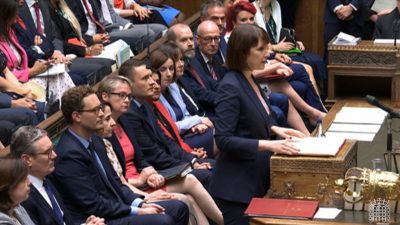UK on red alert over jump in govt borrowing costs

The yield on the UK government’s 10-year bonds hit the highest level Thursday since the 2008 global financial crisis.
The increase makes it more costly for the Labour government to finance current operations and repay the debt, raising the risk it will have to make spending cuts or hike taxes.
What happened?
The yield on 10-year gilts, or UK government bonds, reached a 17-year high at 4.9 percent.
Yields on 30-year debt — an indicator of longer-term confidence in the British economy — raced to the highest level since 1998.
“The leap in gilt yields to multi-decade highs is an extra headwind to an economy that had no momentum at the end of 2024,” noted Paul Dales, chief UK economist at Capital Economics research group.
At 4.9 percent for 10-year debt, the yield exceeded the level struck in 2022 when UK financial markets went into a tailspin following an unfunded budget from the government of then prime minister Liz Truss.
“Today, the UK’s demons are back, driven by heightened fiscal concerns — evoking memories of Liz Truss,” said Ipek Ozkardeskaya, senior analyst at Swissquote Bank.
The 2022 debacle saw Truss lose her job as prime minister after less than 50 days, while her replacement Rishi Sunak was unable to lead the Conservatives to victory in last year’s general election as Labour returned to power for the first time in 14 years.
Why yields surged?
Analysts said concerns about inflation remaining high for longer than hoped is a major reason for the jump in bond yields, mirroring a situation in the United States.
In the UK, sentiment has been further hit by weaker-than-expected economic growth since Labour came to power in July.
Businesses are warning of price hikes after the government of Prime Minister Keir Starmer increased taxes in its maiden budget.
Alongside a tax raid of £40 billion ($49 billion), finance minister Rachel Reeves in October announced plans to borrow more for investment.
Reeves, whose official title is chancellor of the exchequer, followed this up by insisting government departments needed to find efficiency savings.
Evidence of waning confidence in the UK economy has been further highlighted by the British pound tanking this week to around $1.23, the lowest level since late 2023.
“In a short space of time, the UK economy has gone from growing at a decent pace to slowing down sharply, which is causing the wobbles in the bond market,” said Kathleen Brooks, research director at trading group XTB.
Markets around the world are meanwhile taking a hit ahead of Donald Trump’s return to the White House on January 20, with the Republican pledging to impose tariffs from his first day in office.
UK govt reaction?
Should yields on gilts remain elevated, the UK government faces tough fiscal choices according to experts.
“In order to maintain fiscal credibility, the chancellor will have to announce… lower government spending than currently planned and/or higher taxes,” Dales said.
Brooks believes “there are no guarantees that Reeves will be able to calm the market”.
She added: “The market price action is a damning reflection of the Labour government’s economic policies so far, and it suggests a lack of confidence in their ability to fuel economic growth in the UK.”
Speaking Thursday, senior Treasury official Darren Jones insisted that “UK gilt markets continue to function in an orderly way and underlying demand for the UK’s debt remains strong.”
Brooks acknowledged that this was not “a Liz Truss-style moment… largely because pension funds have changed their structures so they are less exposed to a rapid and unexpected rise in gilt yields”.
Analysts added that they do not expect the Bank of England to veer far from its current outlook for interest rates, with markets sticking to forecasts of around three cuts in 2025. (AFP)

